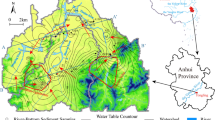Abstract
This paper describes the uranium content analysed in the groundwaters around a restored uranium mine and their impact on the discharge area. A conceptual model for uranium mobilisation in the groundwaters has been proposed: the percolation of oxidised waters, through the fractured granite, produces the oxidation of pyrite and arsenopyrite and the precipitation of iron oxyhydroxides. The dissolution of primary pitchblende takes place and, subsequently, a release of U(VI) species to the solution is produced. These U(VI) species are fixed by silicate species, and they are also retained by iron hydroxides. Secondary uranium species are eventually formed, as reducing conditions are re-established due to water-rock interactions.
Access this chapter
Tax calculation will be finalised at checkout
Purchases are for personal use only
Preview
Unable to display preview. Download preview PDF.
Similar content being viewed by others
References
Abdelouas A, Lutze W, and Nuttall E (1998) Chemical reactions of uranium in ground water at a mill tailings site. Journal of Contaminant Hydrology 34, 343-361.
Al TA, Blowes DW, Martin CJ, Cabri LJ, and Jambor JL (1997) Aqueous geochemistry and analysis of pyrite surfaces in sulfide-rich mine tailings. Geochimica et Cosmochimica Acta 61, 2353-2366.
Al TA, Martin CJ, and Blowes DW (2000) Carbonate-mineral/water interactions in sulfiderich tailings. Geochimica et Cosmochimica Acta 64, 23, 3933-3948.
Berger AC, Berthe CM, and Krumshansl JL (2000) A process model of natural attenuation in drainage from a historic mining district. Applied Geochemistry, 15, 655-666.
Blowes DW, and Patcek CJ (1994) Acid-neutralization mechanism in inactive mine tailings. In Environment Geochemistry of Sulfide Mine-Wastes (eds. J.L. Jambor and D.W. Blowes), Mineralogical Association of Canada Short Course, 22, 271-292.
Bruno J, Duro L, de Pablo J, Casas I, Ayora C, Delgado J, Gimeno MJ, Peña J, Linklater C, Perez del Villar L, and Gómez P (1998) Estimation of the concentrations of trace metals in natural systems: The application of codissolution and coprecipitation approaches to El Berrocal (Spain) and Pocos de Caldas (Brazil). Chemical Geology 151, 277-291.
Buil B (2002) Caracterizacion petrológica, mineralógica y geoquímica y evaluatión del comportamiento geoquímico de las REE en la fase sólida (granitoides y rellenos fisurales) del sistema de interactión agua-roca del entorno de la Mina Ratones. Informe interno CIEMAT/DIAE/54440/1/02. RAT-CIE-IF-04.144p.
Delany J M, and Lundeen SR (1991) The LLNL Thermochemical Data Base- Revised Data and File Format for the EQ3/6 Package: UCID-21658, Lawrence Livermore National Laboratory, Livermore, California
Duro L, Bruno J, Gómez P, Gimeno MJ, and Wersin P (1997) Modelling of the migration of trace elements along groundwater flowpaths by using a steady state approach application to the site at El Berrocal (Spain). Journal of Contaminant Hydrology, 26, 35-43.
Gómez P, Garralón A, Turrero MJ, Sánchez L, Melón A, y Ruiz B (2000) Estudio del efecto de la restauración de la Mina Ratones en las aguas subterraneas. CIEMAT/DIAE/54440/1/00.
Jambor JL (1994) Mineralogy of sulfide-rich tailings and their oxidation products. In Jambor J.L.; Blowes D.W. (Eds). Short Course Handbook on Environmental Geochemistry of Sulfide Mine-Wastes. Mineralogical Association of Canada, 59-102.
Ortño F, Floría E, Carretero G, y Suso J (1999) Caracterización hidráulica de Mina Ratones. AITEMIN. 10-AIT-IA-04.
Parkhust DL, and Appelo CAJ (1999) User’s guide to PHREEQC (Version 2)- A computer program for speciation, reaction-path, ID-Transport and inverse geochemical calculations. U.S. Geological Survey. Water Resources Investigations Report 99-4259.
Pérez Estaún A (1999) Estudios Geológico-estructurales y geofísicos en Mina Ratones. 10-CJA-IF-03.TomoVI
Strömberg B, and Banwart S (1994) Kinetic modeling of geochemical processes at the Aitik mining waste rock in northern Sweden. Applied Gepchemistry 9, 583-594.
Author information
Authors and Affiliations
Editor information
Editors and Affiliations
Rights and permissions
Copyright information
© 2002 Springer-Verlag Berlin Heidelberg
About this paper
Cite this paper
Gómez, P., Garralón, A., Buil, B., Sanchez, L. (2002). Geochemical processes related to uranium mobilisation on groundwaters in a restored uranium mine. In: Merkel, B.J., Planer-Friedrich, B., Wolkersdorfer, C. (eds) Uranium in the Aquatic Environment. Springer, Berlin, Heidelberg. https://doi.org/10.1007/978-3-642-55668-5_38
Download citation
DOI: https://doi.org/10.1007/978-3-642-55668-5_38
Publisher Name: Springer, Berlin, Heidelberg
Print ISBN: 978-3-642-62877-1
Online ISBN: 978-3-642-55668-5
eBook Packages: Springer Book Archive




